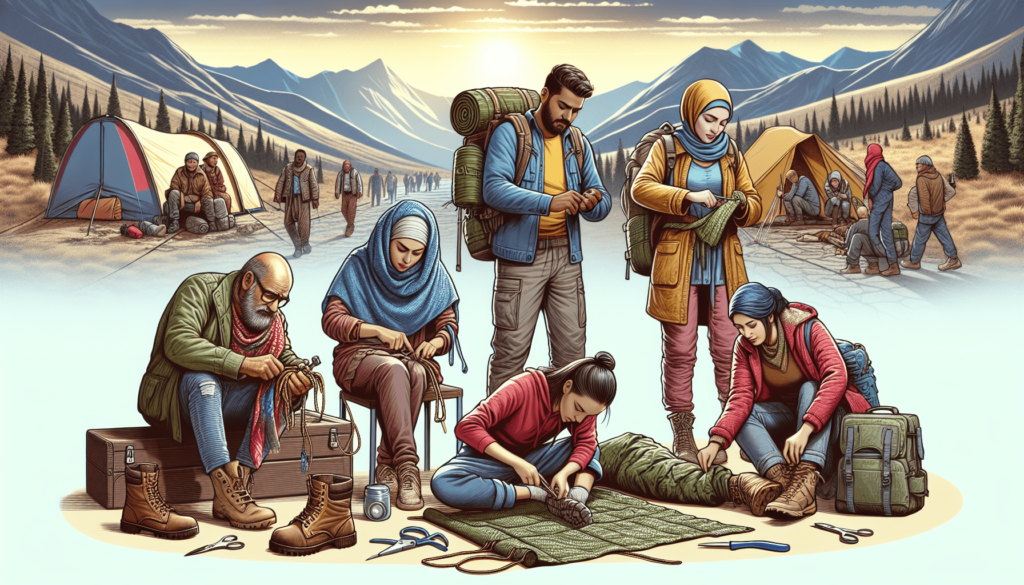In “Field Repairs: Mending Gear And Clothing With Limited Resources,” you’ll discover how to mend your gear and clothing even when resources are scarce. From fixing a torn tent to patching up a ripped backpack, this article will provide you with practical tips and techniques to keep your outdoor essentials in top shape. Whether you’re embarking on a wilderness adventure or simply want to prolong the lifespan of your gear, learn how to make effective repairs using minimal resources. With handy advice and easy-to-follow instructions, you’ll be equipped to tackle any field repair challenge that comes your way.

Importance of Field Repairs
Field repairs are crucial for maintaining functionality in remote locations, avoiding extra expenses, and extending the lifetime of your gear and clothing. When you’re out in the wilderness, far from civilization, it’s important to have the skills and tools necessary to fix any damage that might occur. Being able to handle repairs yourself not only saves you money but also ensures that you can continue enjoying your outdoor adventures without interruption.
Assessing the Damage
Before you can start repairing your gear and clothing, it’s important to properly assess the damage. Take the time to inspect each item for any signs of wear and tear, holes, rips, or broken components. This step will help you determine the extent of the damage and what repairs are needed. By inspecting your gear regularly, you can catch minor issues before they become major problems.
Identifying common issues is the next step in assessing the damage. Whether it’s a broken tent pole, a torn backpack strap, or a ripped seam in your clothing, understanding the common issues that can occur will help you prepare for potential repairs. Additionally, knowing the limitations of the resources you have available is crucial. In remote locations, you might not have access to specialized repair tools or materials. Being aware of what you can and cannot do with the resources at hand will help you make informed decisions about how to proceed with your repairs.
Tools and Materials for Field Repairs
Having the right tools and materials is essential for successful field repairs. Some essential tools for basic repairs include a multi-tool or pocket knife, a sewing kit, duct tape, and adhesive patches. These tools are lightweight and compact, making them easy to carry in your backpack. Consider investing in a lightweight and compact repair kit specifically designed for outdoor repairs. These kits often include items such as repair tape, fabric patches, and specialized adhesives.
In addition to traditional tools, improvisation is a valuable skill when it comes to field repairs. You can use items in your surroundings, such as sticks or rocks, as makeshift tools. Multi-purpose items like carabiners or zip ties can also be used for various repairs. When it comes to materials, alternative options like dental floss or fishing line can be used for sewing and patching. Being resourceful and adaptable is key when you’re faced with limited resources in remote locations.
Repair Techniques for Outdoor Gear
Field repairs for outdoor gear often involve fixing common issues that can occur during outdoor activities. Tent poles and stakes commonly break or bend, but with the right techniques, you can repair them on the spot. Using materials like duct tape, paracord, or even sticks can help reinforce and strengthen these crucial components of your tent. Similarly, backpacks and straps can experience wear and tear, but simple sewing techniques or using paracord can mend them. Sleeping bags and pads can also develop holes or tears, but patching them with adhesive tape or using sewing techniques can extend their lifespan.
Tents and tarps can become damaged from sharp objects or strong winds, but with some adhesive patches or sewing techniques, you can quickly fix them and continue enjoying the outdoors. Broken zippers are another common issue, but with a paperclip or a safety pin as a temporary pull, you can keep your gear functional until a permanent fix is possible. Footwear and gaiters can also suffer from wear and tear, but simple sewing techniques or using adhesive patches can repair them and provide continued protection.

Emergency Clothing Repairs
When it comes to clothing, field repairs are often needed for buttons, fasteners, ripped seams, hems, tears, and holes. Sewing kits with a variety of needles and threads are essential for these repairs. Sewing buttons and fasteners back onto clothing can easily be done with a needle and thread. Ripped seams and hems can be mended by hand with a needle and thread. Tears and holes in clothing can be patched using adhesive patches or by sewing on fabric patches. If you lose or damage cords and drawstrings, they can be replaced with improvised alternatives such as paracord or shoelaces. Waterproof and breathable layers can also be repaired using specialized adhesive patches or sealing tapes.
Adapting and Improvising Gear
In emergency situations, improvisation is key to adapting and using your gear in different ways. Duct tape is a versatile and temporary fix for many outdoor gear repairs. It can be used to patch holes, secure loose components, or reinforce weak areas. Modifying gear for alternative uses can also be a valuable skill. For example, a backpack strap can be temporarily repaired using a length of paracord or a belt. Creating makeshift repair solutions using natural materials, such as using leaves as padding or sticks as splints, can temporarily fix broken or damaged gear until more permanent repairs can be made.
Tips for Successful Field Repairs
Carrying a comprehensive repair kit is crucial for successful field repairs. Make sure your kit includes a range of tools and materials that are specific to the types of gear and clothing you have. Additionally, practicing basic repair techniques in advance will ensure that you are confident and prepared when faced with an actual repair situation. Taking preventive measures, such as regular inspections and proper maintenance, can help minimize the risk of damage occurring in the first place. Finally, don’t hesitate to seek assistance from experienced individuals if you’re unsure about how to repair a specific item or if you want to learn new techniques.
Understanding Limitations and Risks
Knowing when to attempt a repair is important. While field repairs can be a great solution for minor damage, there are times when it’s best to seek professional assistance or replace the item entirely. Attempting repairs on complex or specialized gear without the necessary knowledge and skills can lead to further damage or potential safety risks. It’s important to assess the potential risks and consequences before proceeding with a field repair. Additionally, balancing the need for immediate repairs versus long-term solutions is crucial. While field repairs are great for temporary fixes, it’s important to plan for proper repairs or replacements when you have access to the necessary resources.
Examples of Field Repairs
Field repairs often require creativity and resourcefulness. Here are a few examples of common field repairs:
- Repairing a torn backpack strap with paracord: By removing the damaged section and replacing it with a length of strong paracord, you can quickly and easily restore the functionality of your backpack.
- Mending a tent seam using dental floss: Dental floss is a strong and durable thread that can be used to mend tears and secure seams in your tent, helping to keep you dry and protected.
- Fixing a broken zipper pull with a paperclip: In the event of a broken zipper pull, a paperclip can be used as a temporary replacement, allowing you to continue using your gear until a more permanent fix can be made.
- Patching a sleeping bag with adhesive tape: If your sleeping bag develops a hole or tear, adhesive tape can be used as a quick fix to prevent further damage and maintain insulation.
Maintaining and Cleaning Repaired Gear
Properly storing repaired gear and clothing is essential for maintaining their longevity. Avoid exposing them to excessive moisture or extreme temperatures, as this can degrade the repaired areas. When it comes to cleaning, follow the manufacturer’s guidelines if available. If not, hand washing with mild detergent is often a safe option. Regular inspections and preventative maintenance should be conducted, even on repaired items, to catch any new issues early on. By taking care of your repaired gear and clothing, you can ensure they continue to serve you well on future outdoor adventures.
